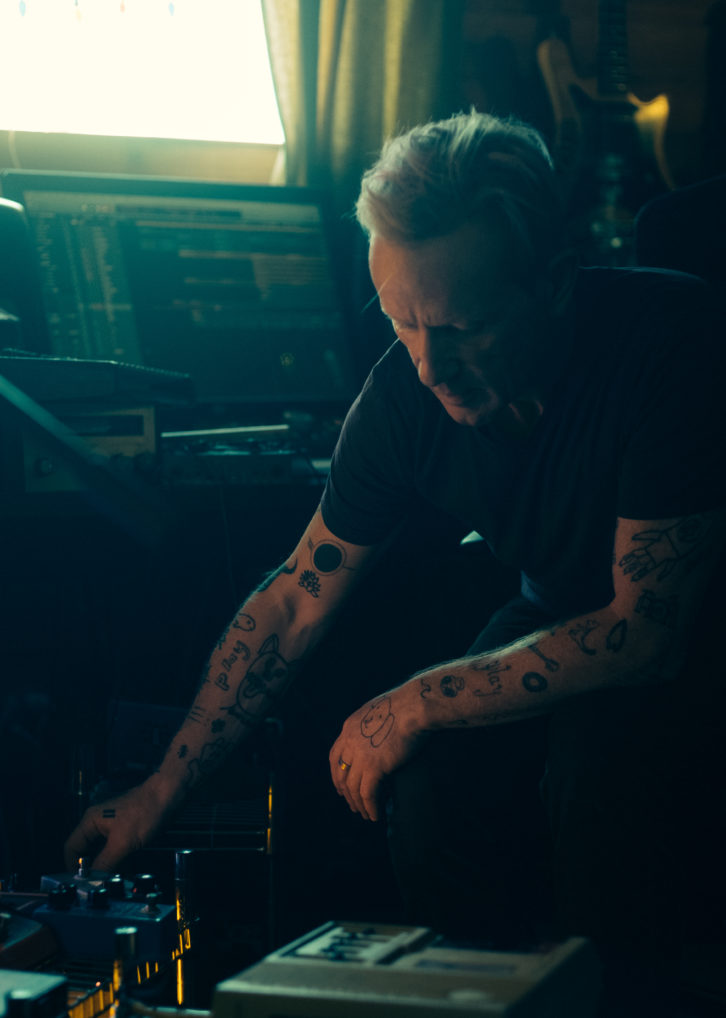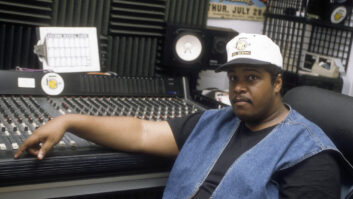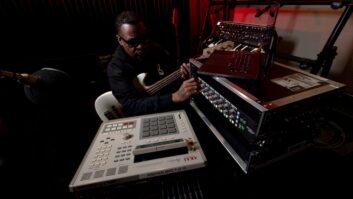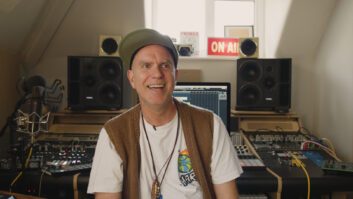
Producer Jacknife Lee never once spoke to the artist during the making of Bamanan. He was riding out the early stages of the pandemic nestled in his Topanga Canyon home studio, near Los Angeles, while Rokia Koné was on the other side of the world in Mali, West Africa, where, besides also dealing with Covid restrictions, an actual coup d’état took place on August 18, 2020, moments after she recorded her vocal for “N’yanyan” in a single take.
Lee came to the project quite by accident. He happened to admire a guitar player named Salif while judging a remix contest sponsored by Real World Records and audio hardware company Universal Audio. When he inquired about Salif, he was led to Koné.
Koné is well-known in Mali. She got her professional start as a backing singer for Alia Coulibaly, one of Mali’s biggest stars, and quickly earned top billing as a solo performer. In 2016, she caught the attention of French booking agency 3D Family’s Valérie Malot, who invited Koné to join feminist supergroup (and later, Real World Records artists) Les Amazones d’Afrique and make her debut on an international stage.
Eventually she ended up back in Mali, recording live in a Bamako studio, backed by the band she performs with in clubs several nights a week. It is that work that fell into Lee’s hands.

MEET JACKNIFE LEE
The producer, writer and collaborator, known for work with such artists as R.E.M, Snow Patrol, the Cars and Weezer, is no stranger to working alone. He’s been working this way for a while now. “U2 would be on tour, and they would send me some demos and I would just work on them,” says Lee, whose work on the band’s How to Dismantle an Atomic Bomb earned him two Grammy Awards back in 2004.
“You get great things when people are in the room together, obviously, but when I’m experimenting or exploring an idea, sometimes I have to go really far off the initial intention,” he explains. “If I love something and it’s not finished, sometimes I have to be very bold with the idea. A lot of my breakthroughs happen when mistakes occur. Like with ‘N’yanyan,’ [referring to a song that ended up as a vocal-only track, though it didn’t start out that way] “If the room were full of musicians, everyone would be playing and I would never have gotten to hear it with just the vocal, and I wouldn’t have gotten the space to do it the way I did it.”
That makes sense, as it was her voice on the song “Anw Tile” that first captivated the producer when he received the first batch of files from Koné’s booking agent, Valérie Malot. And it was the vocal that became the focus throughout.
“I started with the vocal and built everything around it,” Lee explains. “That was the goal from the beginning. Vocal front and center. I mix as I go, so from the moment I’m working, the mix has begun. It’s not a separate process. Most times, a vocal is put on the track last, so it can be difficult to place. This way prevented that from being a problem.”
Even though he had no clue what Koné was singing about, the meaning was conveyed in her soulful delivery. “This is gospel music,” he attests. “It’s meant to touch God. I’m not religious, but I do recognize spirituality when I hear it. She was unafraid of being out of tune. She was unafraid of not getting to the note she was going for. It was real, without any affectation, and she wasn’t trying to impress anybody with her voice. She was singing because she needed to.”
Lee received the music in lengthy, unfinished, jam-like songs. The musicians sounded much like a “bar band,” he thought, so the first thing he did was strip them from the files and start from scratch. “I thought, ‘I’m going to have to be bold,’” he recalls. “I was awed by her voice and thought, ‘I have to do something with this because I said I would.”
BUILDING A SONG
Lee records in Logic Pro, primarily using Universal Audio Apollo interfaces, but, he says, everything on the record was played—“a lot of technology, old synths, a mixture of tape loops, digital things.” The song “Bambougou N’tji” provides a prime example of his working method.
“It took me ages to figure out the tempo on the original version because they were doing it live,” he says. “It was in 3/4, and that isn’t an obvious tempo, so I thought I would put an arpeggio from my DX7 and play it similar to how Conny Plank used to do with D.A.F. records, where they’re doing a sequence, but as a sequence is going, they’re playing a keyboard as well, so you get kind of glitches. It stops it from being static.
“Then I ran a slightly different sequence on my Roland Super Jupiter, so they’re kind of phasing,” he continues. “They’re out of time with each other, and sometimes they’re going and sometimes not. Then I’ve got my Arp-2600 doing a kind of inappropriate string line.
“Then Salif Koné has an insanely good guitar part that is kind of muted, and I chopped up every single note so they are just blips, and I made another sequence that would go against the DX7 and the Jupiter. On the original session, someone played a Minimoog, which was a real delight, so that’s on there, chopped up.” Lee realized he had to add a beat in 3/4, so he used his Arturia DrumBrute and then put a delay on it in 4/4 with his Yamaha analog 1010E.
IDLES Finds Room to Explore at Real World, Part 1
“Then there’s an instrument on the original version called a dunun, which I chopped up, and a djembe that I chopped up to be a rumbling, rolling thing, not in 3/4 anymore,” he says. “Then I added my favorite snare, which is called a (Pearl) Firecracker with a super tight head, and it almost sounds like a snare drum mixed with a bell or a timbale.”
On the chorus, Lee uses pads from the Korg M1, which he says he ignored for years because he thought it sounded “cheesy,” but he now loves the sound all over again. He brings in another sequence, which provides counter-rhythm, a la Steve Reich.
“Then there is a vocal call and response with the background vocals, and I have a Korg Delta, which is a kind of string synth from the ’70s, and that’s doing a kind of hip hop, piano-y organ thing. Then more loops with this toy piano from Critter & Guitari, and then another sequence going through a Neon Egg Planetarium 2 pedal that has delays and reverbs and compressors. Then a third pad comes in from my Oberheim OB8, a very ’80s thing, and then I took a guitar loop from Salif.”
The ending returns to Kone’s voice and the sequencers, Lee says, with her vocal track run through an Eventide Harmonizer 3000 (“to give it width”) and the lone piece of software he used on this track, a Valhalla Vintage Verb.
When asked how long the record took him, Lee says that he honestly lost all track of time.
KONÉ HEARS THE MIX
Through an email exchange via an interpreter, Koné told Mix: “When I first heard Jacknife’s work on the songs, I was actually a little bit shocked because they sounded so different to the original songs. It is not a typical sound we hear in Mali. Before long, I really grew to love what he had done. He was very respectful of my music in the work he did.”
Bamanan was released in mid-February on Real World Records, and Koné says she is proud of how the record came out.
“I hope that we can only bring more strength to Malian music and how it is viewed on the international scene,” she wrote. “I hope to show that our music is very versatile and can be presented in many ways—through jazz, blues, reggae or even electronic music. We can find ourselves comfortable in all of these forms.”
For Lee, work that involves a spiritual connection, something that stirs a feeling within, has become increasingly important to him.
“I have two girls, 19 and 20, and they are looking at their lives and I’m trying to be an example to them of what choices to make,” he explains. “There are good choices and bad choices, and if I say follow your heart or follow your passion and I’m not doing it, it’s a lie. I’m happier this way and bringing a lot more joy into my life, and I’m listening to music in a way that’s totally pure. And I’m making better records as a result.”







